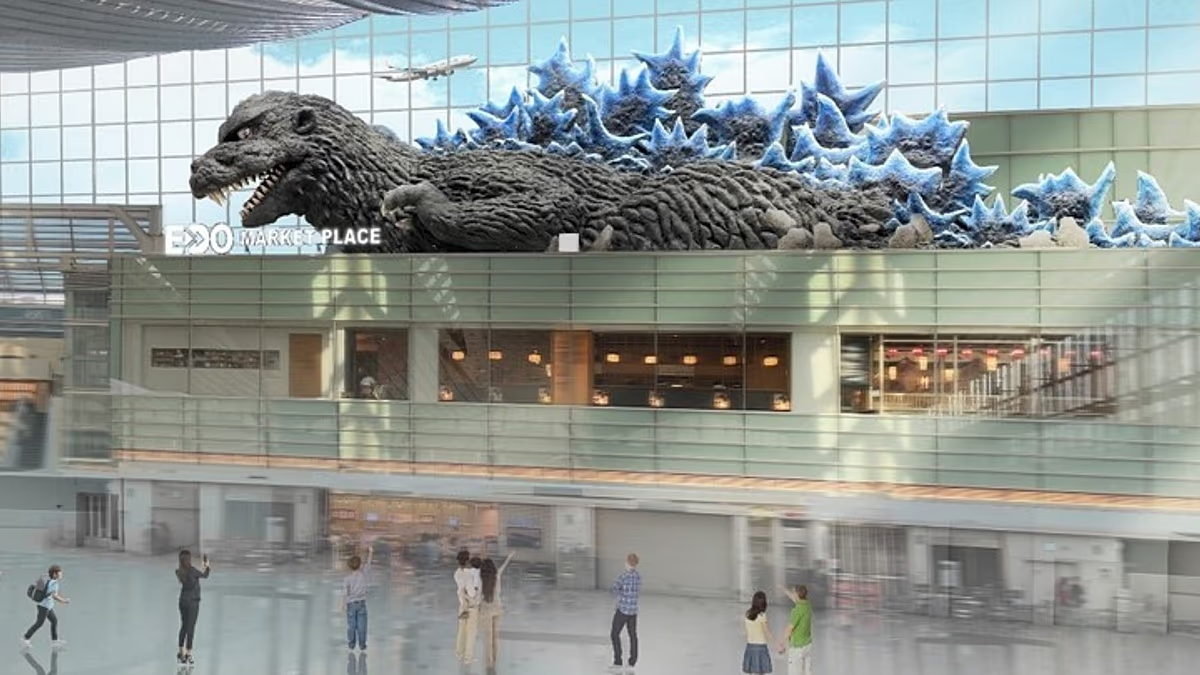Godzilla Becomes Tokyo’s Newest Airport Ambassador: A Sign of Japan’s Evolving Tourism Landscape
Japan has always found creative ways to welcome visitors, but its newest airport greeter might be the most dramatic yet. Starting this December, travelers passing through Tokyo’s Haneda Airport will encounter an extraordinary farewell: a massive Godzilla installation bursting through the walls of the departures lobby. This colossal statue, measuring an impressive 40 meters wide and nine meters high, will become a fixture at Japan’s busiest airport for a full year, until December 2026. The installation represents a perfect blend of Japan’s pop culture prowess and tourism innovation, giving departing visitors one final memorable glimpse of the country’s unique cultural landscape. Those arriving at Haneda won’t miss out either, as they’ll be greeted by a smaller but equally imposing statue from the acclaimed 2023 film “Godzilla Minus One,” alongside images of the iconic monster and other creatures from the franchise displayed prominently above the information counter in the terminal’s second-floor arrivals lobby.
This ambitious airport installation marks an interesting chapter in Godzilla’s seven-decade history. Since first appearing on screens in 1954, the legendary kaiju has starred in more than 30 films both in Japan and internationally, becoming perhaps Japan’s most recognizable fictional export. The airport project represents a collaboration between Toho Co., the studio behind the Godzilla films, and Haneda Airport’s operators, designed specifically to create a lasting impression on travelers and showcase a quintessential example of Japanese entertainment and design. While Godzilla has demolished countless fictional versions of Tokyo over the years, this might be the first time the legendary monster has been officially invited to “destroy” part of a major transportation hub. The timing couldn’t be better, as Japan’s international tourism has reached unprecedented heights, with more than 31 million foreign visitors recorded in just the first nine months of 2025 alone, highlighting the country’s continued appeal as a global destination.
Japan’s tourism boom shows no signs of slowing, yet most visitors still gravitate toward the same well-known attractions in Tokyo, Kyoto, and Osaka. While these cities certainly merit their popularity, the Godzilla installation at Haneda serves as a reminder of Japan’s diverse offerings beyond the traditional temples and cherry blossom spots. The country boasts countless less-crowded yet equally rewarding experiences for travelers seeking alternatives to the standard tourist circuit. Take Gifu Prefecture, for example – a region known for its picturesque snow-covered villages, centuries-old sword-making traditions, and peaceful hot springs that provide authentic Japanese experiences without the crowds. This more relaxed approach to exploring Japan allows visitors to engage more deeply with local customs and environments, often leading to more meaningful travel experiences than simply checking off famous landmarks from a guidebook list.
Just a short train ride from both Kyoto and Tokyo lies Hokuriku on Japan’s west coast – another region offering remarkable natural landscapes, exceptionally fresh seafood, and beautifully preserved samurai and geisha districts, all with significantly fewer visitors than its more famous neighboring destinations. These less-traveled regions present opportunities to experience Japan’s rich cultural heritage in settings that feel more intimate and genuine. The country’s efficient transportation system makes these alternatives easily accessible, allowing travelers to combine popular highlights with off-the-beaten-path discoveries. Japan’s geographic diversity means visitors can experience everything from tropical beaches in Okinawa to the wild, unspoiled nature of Hokkaido, all within a relatively compact nation. This accessibility of varied landscapes and cultural experiences remains one of Japan’s strongest appeals for repeat visitors looking to discover new facets of the country beyond their initial impressions.
Another emerging trend reshaping Japan’s tourism landscape is cinematic tourism – the practice of visiting real-world locations featured in popular films, television shows, and anime. Much like travelers in other countries seek out filming locations from beloved productions, visitors to Japan increasingly structure their itineraries around scenes from their favorite Japanese media. This approach offers a unique lens through which to view the country, whether exploring Tokyo’s neon-lit districts featured in cyberpunk films, visiting the rural towns that inspired beloved anime settings, or seeking out everyday scenes recognizable from Japanese cinema. This form of cultural tourism creates deeper connections between visitors and the locations they explore, as they experience places not just as generic tourist spots but as settings with narrative significance and emotional resonance. The Godzilla installation at Haneda Airport taps into this same desire for immersive, story-driven experiences that bridge fiction and reality.
As Japan continues to welcome record numbers of international visitors, initiatives like the Haneda Airport Godzilla installation represent the country’s creative approach to tourism. Rather than simply promoting traditional cultural sites, Japan increasingly embraces its modern cultural exports as equally valuable attractions. This balance between ancient traditions and contemporary pop culture creates a multifaceted destination appealing to diverse interests and generations. The massive Godzilla breaking through the airport walls serves as both a spectacular photo opportunity and a symbolic reminder of Japan’s ability to continuously reinvent itself while honoring its unique cultural heritage. For travelers departing Japan after experiencing its blend of historical treasures, natural beauty, technological innovations, and pop culture phenomena, a final glimpse of the country’s most famous monster makes for a fitting farewell – one last memorable encounter with Japan’s distinctive creative spirit before taking to the skies.


